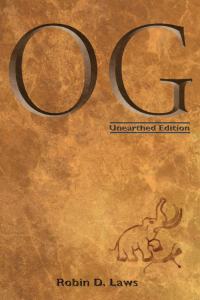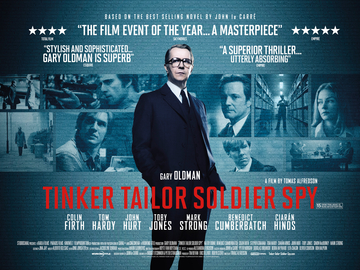I started watching Game of Thrones recently, and Hodor got me thinking about magic. In some oblique ways.
RPGs are mostly a discussion. Speech and writing, in their tabletop and PBM incarnations, are almost inherent to the form. This happens because there are not enough physical game tokens to allow expression of all the subtleties of what happens in the game world. For a NON RPG, like the DND 3E miniatures game, the need for speech is absent: it’s possible to move tokens and roll dice and point at tokens, and that’s enough to resolve the game.
Note that this has nothing to do with system completeness: it’s possible to have an incomplete system needing arbitration, where the referee resolves combats by moving, changing, adding and subtracting “bits” from the table, not a word spoken.
Speech at this level is about the world. Players make statements about the world and roll dice, which are about the world. The referee adjudicates and reports the results. So, we are playing, and this is the nature of the game: making statements about the world.
There is another level of need for speech, which is the speech that happens in game: characters talk to each other. The player of Hodor has problems with that. I played a speech-impaired character once and it was funny and challenging (the system was Fate though, which was the only negative note, because all players and the GM did a brilliant job).
At any rate, Hodor can’t speak. Hodor can act though. Which would be incredibly interesting if Hodor was in a game of Diplomacy.
Hodor is a bit extreme though. Let’s talk about Robin Law’s OG.

OG is a gem. In OG you character knows how to use 3-8 words. You can unleash the very full panoplia of your extensive vocabulary when interacting with the Referee, but with other players? Stick to your own 3-8 words! If you know only “small”, “stick” and “you” you can’t say many things that do not insult virility. And that’s kind of cool because it’s a game made fun by its special player interaction.
It would be interesting if RPG magic was the same. Incidentally the first fantasy novel I read was A Wizard of Earthsea by U.K. le Guin, which has a system that is basically UG-Magic-University. You learn words for things, so that you can command them. And humans get baptized, so if you don’t know their real secret name you have to use their “common name”, which is what they use in daily life, or just use “dude”.
So, if you want a flexible rulelight magic system, one that is a bit crazy but completely not playtested, enjoy this one:
You MU begins the game knowing INT/3 names for generic things and 1 mana. When a new level is gained, one new name is learnt and 1 mana per level is gained. You might want to use a foreign language (French? Italian? Lithuanian? Japanese? Kurdish? Finnish? Tsolyáni?) for the special names to stop your character from using them in play. They become game tokens, so you to avoid messups you want to be specific when referring to them. Or you can trace runes mid-air or pronounce the rune names. Whatever. Words have power.
To cast a spell, tell to the Referee ALL the words you are using this round. For example for Fireball would maybe be “big powerful fire blast there”, while Create Fire would be “fire”. Then, using the 5MORE system or rolling under INT or under CHA or trying to SAVE, roll once for every word you pronounce in the round. Consider every word as a different TASK for 5MORE EXPERT purposes.
You need to succeed at every word check to cast the spell. If you fail a roll, spend 1 mana to convert it to a success. If you elect not to spend the mana, all the words you are speaking in the same round get messed up and are all counted as failures. So yes you can take time casting a spell.
When you are done with words, something happens. The Referee will let you know what happens depending on the words that failed. As a yardstick, consider that a comparable D&D spell should have (2 x level) – 1 words. The referee and players are encouraged to write down combination of words of power, and the referee is encouraged to have the same combination of words have the same effect every time. Players should record combination and effects only if their characters have writing implements.
Now, this seems eminently more powerful than D&D. Surely it’s more flexible, and if you’re lucky it gives you infinite free spells at level 1.
But.
Failures.
Bite.
There are two consequences for failures.
The first one is that the caster gets burnt.
- For each word failed, the caster can’t use that word for 1d6 turns.
- For each three words failed, the caster takes 1d6 damage OR the caster can spend one mana OR the caster can get stunned. The caster can choose which as they know how to fend off magic power. Stun duration is 1d6 rounds if chosen once, 1d6 turns if chosen twice, 1d6 hours if chosen 3 times, then days, weeks, months, seasons.
- For each six words failed, something awful happens. Maybe the caster gets whisked away by a gate for a while, or they develop a horrible mutation. I’ll let your Referee adjudicate.
So if a caster fails seven words, they can’t use any of them for 1d6 turns, takes three times a mixture of 1d6 damage or 1 mana damage or stunned for 1d6 rounds/turns/hours, and something horrible happens.
Plus, there is the second consequence. Magic happens regardless. Referee, consider that magic has a personality. And that words have personalities. And that some words don’t like being used close to each other. Let them play. You might even have the words make reaction rolls against each other and the MU to determine if the play nice. Mispronounced words will most probably misbehave at some level, and the caster might even pronounce other words instead of the failed one.
Note that if a spell targets someone, using a generic name (like “human”) grants an additional save, while using the Secret Name forces the victim to reroll 1 succeeded save.
You can learn new words from other people
Note that you can totally use this system as rune magic too.













